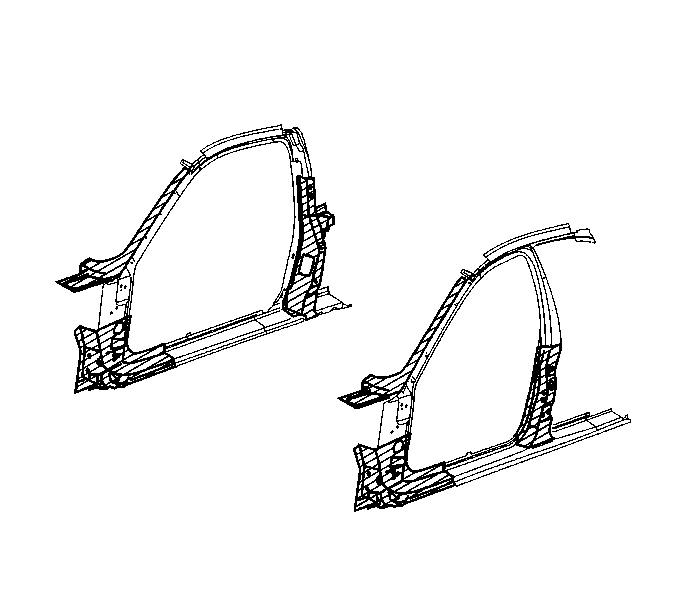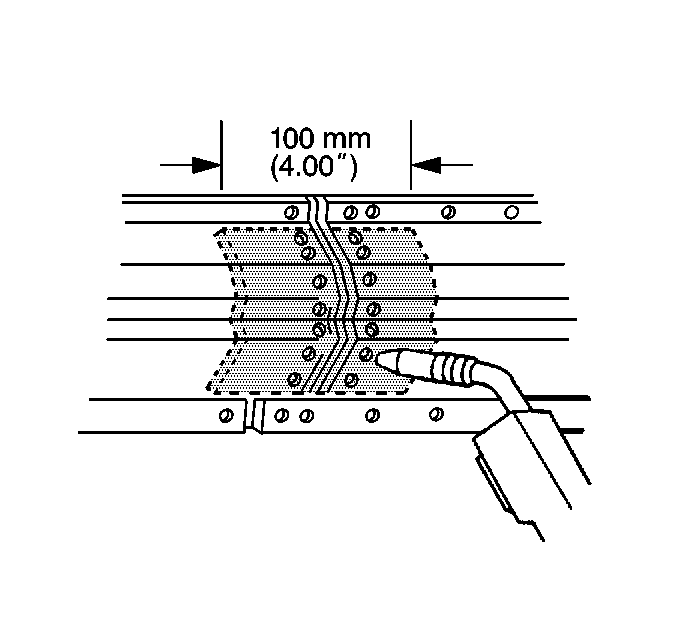Removal Procedure

Important: There are some key areas where sectioning should not take place. Sectioning
in these areas may compromise the structural integrity of the vehicle.
- When you section areas other than the hinge pillar, use a 100 mm
(4 in) backing plate behind the joint.
| • | This ensures a solid and secure weld in areas where there is
no inner reinforcement. |
| • | Backing plates an usually be cut from the unused portion of
the service part or the damaged section of the door frame opening. |
| • | The rocker panel can be replaced as a whole unit when the quarter
panel is removed. |
| • | Visually inspect and restore as much of the damage as possible
to factory specifications. |
- Remove all the related panels and the components.
- Remove the following components as needed:
| • | The corrosion materials |
- Cut the door frame opening where the door will be sectioned. Do
not damage any inner panels or reinforcements.
- Locate, mark and drill out all necessary factory welds. Note the
number of welds for installation of the service part.
- Remove the damaged section of the door frame opening.
Installation Procedure

- Cut the service part in
order to match the undamaged section of the door frame opening. Remove the
unused portion of the service part.

- Cut a 100 mm (4 in)
backing plate from the unused portion of the service part or damaged section
of the door frame opening. Modify the backing plate as necessary so
that the backing plate fits behind the sectioning joint.
- Drill 8 mm (5/16 in) plug weld holes as necessary
on the service part in the locations noted from the original section.
- Drill the plug weld holes along the sectioning cut on both the
service part and the remaining original part. These will be used to weld the
panel to the backing plate.
- Prepare the mating surfaces.
Important: The sectioning joints should have a gap of approximately 1 ½ times
the thickness of the metal to ensure a secure weld. Trim the parts as necessary
to achieve this.
- Slide the backing plates 50 mm (2 in) beneath the sectioning
cuts on the vehicle. Plug weld the backing plates in place.
- Position the service part. Allow the service part to overlap the
exposed 50 mm (2 in) of the backing plates.
- Check fit using the body dimensions.
- Plug weld accordingly with frequent measurements to ensure proper
fit.
- Stitch weld along the sectioning joints. Make 25 mm (1 in)
welds along the seam with 25 mm (1 in) gaps between.
- Complete the stitch weld. This will ensure a solid joint with
minimal heat distortion.
- Complete all other welds as necessary.
- Clean and prepare the welded surfaces.
Important: Prior to refinishing, refer to GM P/N 4901MD-99 Refinish
Manual for recommended products. Do not combine paint systems. Refer to paint
manufacturer's recommendations.
- Prime all bare metal areas with two-part catalyzed primer.
- Apply sealers and corrosion protection materials as necessary.
- Install all the related panels and the components.



